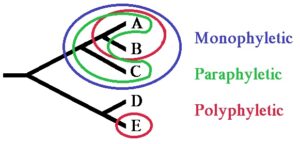Monophyletic group or Monophyletic group example also called as the clade is the naturally occurring group of organisms that have a single or the common ancestor.
- Mammals
- Birds
- Angiosperms
- Insects
- Lions
- Echidnas
- Komodo dragons
- Crocodiles
- Humans and Great apes
Mammals:
In evolutionary terms, all marine mammals descend from a single and common ancestor and hippos are the closest living relatives of whales, dolphins.
Birds:
Birds are one of the best examples that fall under the monophyletic group as all the birds have a common and single ancestor. Right from the shape, their body morphology till their level of intelligence and swift movement, all the birds descend from a single ancestor.
Angiosperms:
When asked about plants, each and every one of us would definitely relate to them with the bright, radiant and supremely blooming flowers. So, yes the flowering plants or the technical term, angiosperms are a great example of a monophyletic group as they are under Magnoliophyta, or Anthophyta.
Insects:
All the arthropods certainly fall under the monophyletic group and the reason is similar to that of birds (shape, their body morphology etc).
Lions:
A good example of monophyletic group, an adult male lion is larger and has a longer tail than a female and has a rougher coat than the female. Lions are found in Africa and India, where they have a muscular body with a broad chest, a short rounded head, and round ears.
Echidnas:
A solitary mammal of medium size covered in coarse hair and spines, echidnas are medium-sized and solitary. Same like in few animals which have fur (hair), claws (clamp like nails), nails, and sheaths of horn, spines are made of a protein called the keratin, the same fibrous amino acid linked poly-peptide protein that builds up animal fur, claws, and nails.
Komodo dragon:
Using mitochondrial DNA, genetic analysis reveals that the Komodo dragon is the a very close relative (sister taxon) of the lace monitor (V. varius), with their common ancestor distinguishing from the lineage that gave rise to the crocodile monitor (Varanus salvadorii) of New Guinea.
Crocodile:
This study ( Are crocodiles really monophyletic? Evidence for subdivisions from sequence and morphological data-L. Rex McAliley, United States Department of Agriculture) uses molecular and morphological techniques to address the phylogenetic placement of the African slender snouted crocodile, Crocodylus cataphractus.
Cataphractus is often considered a “basal” form of Crocodylus, but morphological studies have traditionally placed it within the genus Crocodylus, while molecular studies suggest that it is very different from other Crocodylus.
Humans and Great apes:
Based on a cladogram, humans and chimpanzees show a common ancestor with the tribe called hominini. The Gorillini tribe is where gorillas share a common ancestor. It is believed that both tribes, Hominini and Gorillini, share a common ancestor in the subfamily Homininae.
Based on analysis, humans, bonobos, chimpanzees, and gorillas would be considered into the monophyletic group because they share the same features, DNA, and a common ancestor.
What is a monophyle?
This is a portion that comes in evolutionary biology.
In cladistics, a monophyle is a group of organisms that share only one common ancestor (or, more precisely, one ancestral population) with all of its descendants.
What is Paraphyly and how are they different from monophyle?
- In the terms of evolutionary biology, a paraphyletic group is one that has a common ancestor and some descendants, but not completely each and everyone.
- Example of Paraphyly: Reptilia

Image credits- Wikimedia
- In biology, monophyletic refers to, relates to, or affects a single phylum (or other taxon) of organisms, whereas paraphyletic refers to a defined group of taxa, without including all descendants of the common ancestor of all members.
- Example of monophyletic group: Mammals, Birds, Angiosperms, Insects, Lions, Echidnas, Komodo dragons, Crocodiles, Humans and Great apes
Summary:
This article summarizes the monophyletic examples and their characteristics. They are the group of organisms which have a common and single ancestor.
Also Read:
- Are endonucleases restriction enzymes
- Red algae examples
- Bacillus examples
- Artificial ecosystem example
- Is endocytosis diffusion
- Saturated fatty acid
- Does fermentation occur in the mitochondria
- Dna replication vs polymerase
- Examples of monocot
- Purple sulfur bacteria photosynthesis

Hello, I am Sugaprabha Prasath, a Postgraduate in the field of Microbiology. I am an active member of the Indian association of applied microbiology (IAAM). I have research experience in preclinical (Zebrafish), bacterial enzymology, and nanotechnology. I have published 2 research articles in an International journal and a few more are yet to be published, 2 sequences were submitted to NCBI-GENBANK. I am good at clearly explaining the concepts in biology at both basic and advanced levels. My area of specialization is biotechnology, microbiology, enzymology, molecular biology, and pharmacovigilance. Apart from academics, I love gardening and being with plants and animals.
My LinkedIn profile-